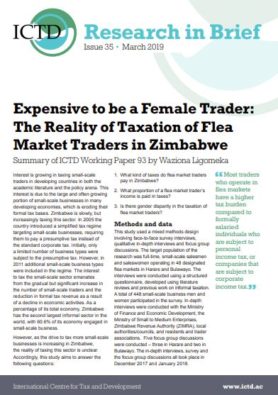Research in Brief 35
Interest is growing in taxing small-scale traders in developing countries in both the academic literature and the policy arena. This interest is due to the large and often growing portion of small-scale businesses in many developing economies, which is eroding their formal tax bases. Zimbabwe is slowly, but increasingly taxing this sector. In 2005 the country introduced a simplified tax regime targeting small-scale businesses, requiring them to pay a presumptive tax instead of the standard corporate tax. Initially, only a limited number of business types were subject to the presumptive tax. However, in 2011 additional small-scale business types were included in the regime. The interest to tax the small-scale sector emanates from the gradual but significant increase in the number of small-scale traders and the reduction in formal tax revenue as a result of a decline in economic activities. As a percentage of its total economy, Zimbabwe has the second largest informal sector in the world, with 60.6% of its economy engaged in small-scale business. However, as the drive to tax more small-scale businesses is increasing in Zimbabwe, the reality of taxing this sector is unclear. Accordingly, this study aims to answer the following questions: 1. What kind of taxes do flea market traders pay in Zimbabwe? 2. What proportion of a flea market trader’s income is paid in taxes? 3. Is there gender disparity in the taxation of flea market traders? This ICTD Research in Brief is a two-page summary of ICTD Working Paper 93 by Waziona Ligomeka.
